Dobsonian telescopes are what I usually recommend to beginners. If you ask most astronomy clubs, websites, or observatories, they’ll probably respond in unison: “Get a Dob.”
Heck, half of my personal telescopes are Dobsonians.
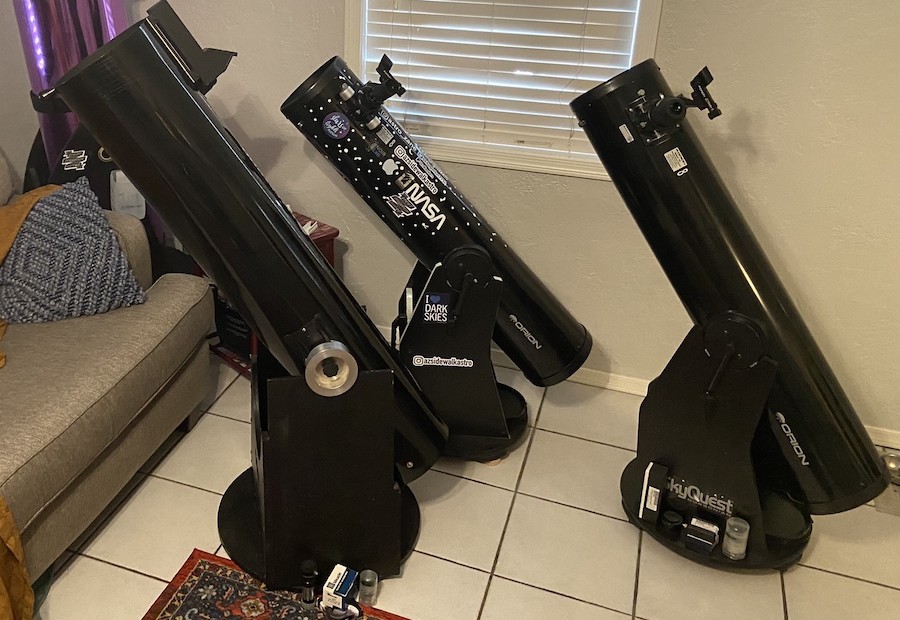
Anything that is 10” or above and is either cheap or portable is going to be a Dobsonian. The design just works. The famed San Francisco monk’s simple, pioneering design allows for a smooth-moving, easy-to-use telescope that puts as much money as possible into the optics and simply gives you the most bang for your buck.
Beginner telescopes on tripods seem to be sold almost entirely because they “look like a telescope”, whereas Dobsonians look kind of strange by comparison. Don’t be fooled.
A full-sized Dobsonian remains easy to use and ideal for visual astronomy even when you get some big, expensive astrophoto setup later on.
At higher price points, Dobsonians tend to diversify a lot, and it gets difficult to pick the best dob among them. You have to decide whether you want GoTo, digital setting circles, or an entirely manual instrument. Also, there are numerous other design features that often make it hard to really nail down a single “best” Dobsonian telescope in one price bracket.
Best Dobsonian Telescopes Overview

First off, here are our top Dobsonian recommendations straightaway, in case you don’t want to read them in detail. These recommendations hold true if you are looking for the best deep-space viewing telescopes as well, since Dobs are perfect for visual deep-sky observation (not deep-sky photography, though).
- Best 6″: Bresser Messier 6″ Planetary – A full-sized 6″ Dobsonian doesn’t need a table but is still surprisingly lightweight and portable—while being vastly easier to collimate than its shorter tabletop Dobsonian cousins. If it’s all you can afford, a 6″ Dobsonian is a good choice, and of those, the Bresser Messier 6″ Planetary is well-crafted.
- Best Budget 6″: Ursa Major 6” f/8 Planetary – The Ursa Major 6” f/8 dobsonian, a budget option, offers everything you need to get started, though its mechanical design limits your room to grow into things like 2” eyepieces.
- Best 8”: StellaLyra 8” f/6 – The best bang-for-your-buck telescope from First Light Optics. As with its American counterparts from Apertura, it is one of our most highly recommended telescopes for good reason – it offers fantastic optics, mechanics, and a decent included accessory bundle, all at a staggeringly low price. It’s the best value-for-money telescope ever sold.
- Best Computerised 8″: Celestron StarSense Explorer 8″ – While it doesn’t come with as many features or accessories as the StellaLyra 8″, it features Celestron’s easy-to-use StarSense Explorer navigation aid.
- Best 10″: StellaLyra 10″ f/5 – The accessories, features, and focal length are the same as the remarkable StellaLyra 8″, and the scope is only a tiny bit more bulky, but the views are over 56% brighter than an 8” scope!
- Best 10″ Computerised: Celestron StarSense Explorer 10″ – Like the 8″ version, this model doesn’t come with many features or accessories but features Celestron’s easy-to-use StarSense Explorer navigation aid. It is remarkably lightweight, and aiming it around the sky is a breeze.
- Best 12″: StellaLyra 12” f/5 – The sheer size and bulk of the 12″ solid-tubed design necessitate either a strong user and large vehicle or an easy setup, such as rolling out of a garage. If you’re willing to put up with the hassle, the StellaLyra 12″ will deliver images that are nothing short of spectacular. The StellaLyra 12” f/5 Dobsonian may be bulky, but it delivers a huge aperture at a lower price than any of its competitors with the same excellent features/accessories as the smaller StellaLyra scopes.
- Best Portable 12″: SkyWatcher Skyliner 300P FlexTube – The Sky-Watcher Flextube Dobsonians have some compromises in their design that make the 8” and 10” models rather unappealing, at least as a first choice. However, the Flextube 300P is significantly more portable than a solid-tubed 12″ Dobsonian telescope, such as the StellaLyra 12″. Its collapsable tube can fit across the back of a vehicle, whereas the long tube of a conventional 12” will need to have seats folded down – and plenty of available cargo space – to be transported.
- Best Computerised 12″: SkyWatcher Skyliner 300P FlexTube GoTo – This GoTo version gives you motorised tracking regardless of whether you need assistance in finding objects, making it an excellent upgrade from the standard edition.
- Best 14″: Sky-Watcher Skyliner 350P FlexTube GoTo – The FlexTube 350P further improves upon the 300P GoTo with a dual-speed focuser, more aperture, and a fully collapsable Dobsonian base, too.
- Best 16″: StellaLyra 16″ f/4.5 Dobsonian – It is among the best we’ve tested, and it’s significantly more portable than the Sky-Watcher FlexTube options. However, it’s a little bit difficult to get up and running.
In this guide, I’ve excluded the smaller, tabletop Dobsonians, which are among our highest recommended telescopes in the under-£300 price range. While technically Dobsonians, these scopes lack the double-armed rocker boxes of a true Dob and don’t sit on the ground. But a tabletop Dobsonian will last you even after you’ve moved on to more advanced and complicated equipment, as it remains an easy-to-use, portable grab-and-go scope.
We’ve put together a ranking page of all the tabletop Dobsonians currently available in the UK, if you’re interested.
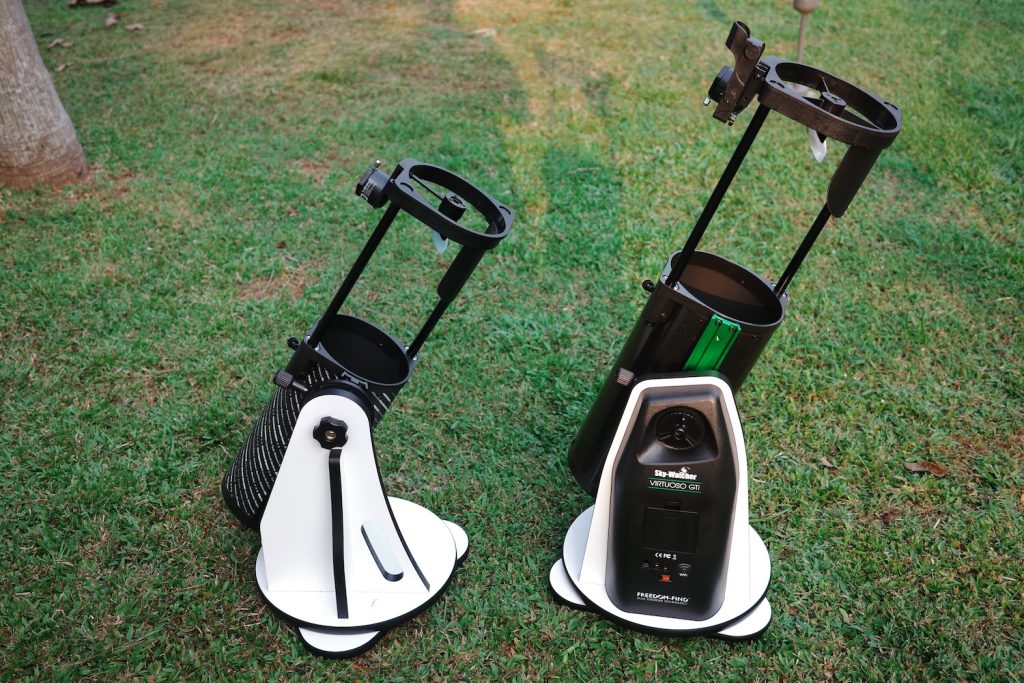
Recommended Best Dobsonians Individually Reviewed
1. Best Budget 6″ Telescope: Ursa Major 6” f/8 Planetary Dobsonian
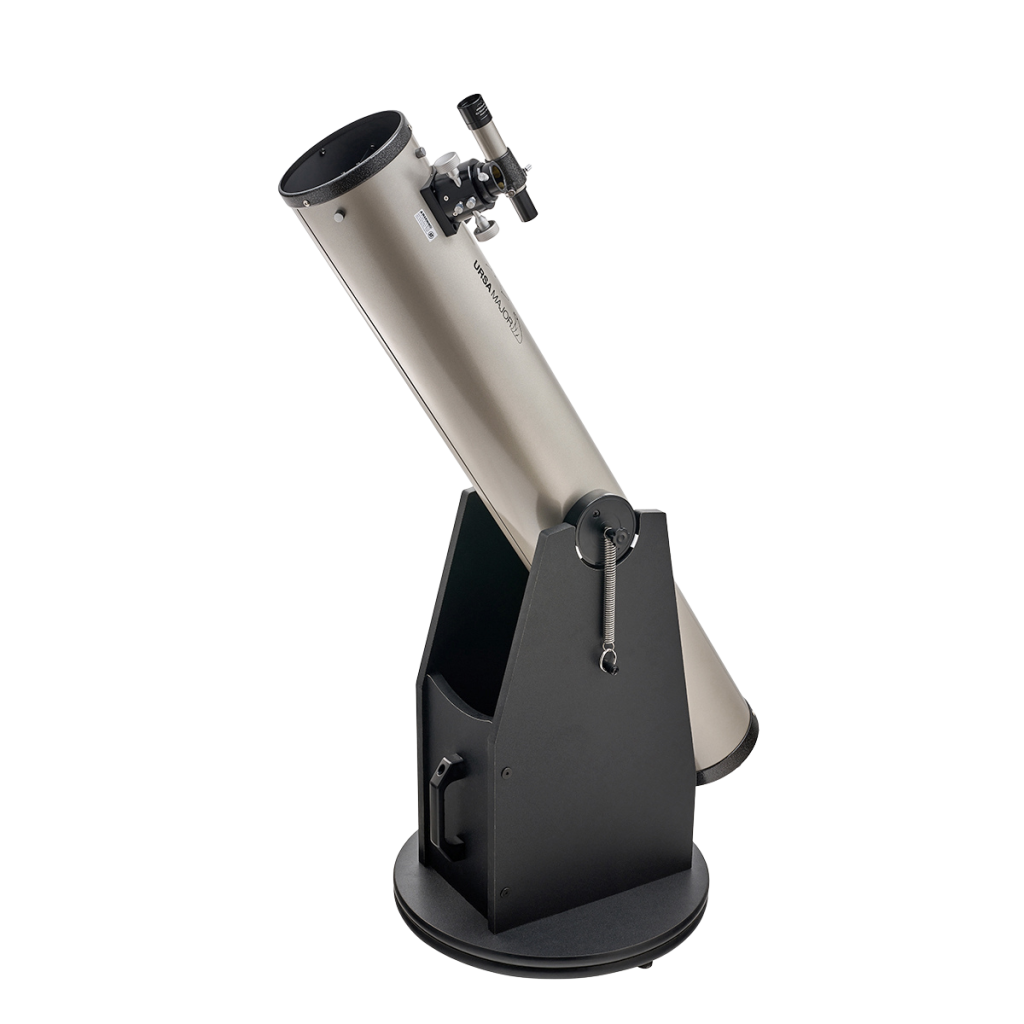
- Cheapest
- Easy collimation
- Does everything any more expensive 6” can, view-wise
The Ursa Major 6″ Planetary Dobsonian Telescope is uncomplicated and reasonably priced, yet comes packed with enough potential to keep you engaged without inducing boredom or frustration. For the enthusiast who might already own a larger scope, this 6″ Planetary Dobsonian from Ursa Major presents itself as a perfect “grab and go” telescope.
It easily accommodates your heavier eyepieces, offering spectacular visuals while negating the necessity for fussy collimation, substantial cooldown periods, or convoluted assembly and setup procedures. It’ll show you the entire Messier catalogue as well as many other deep-sky objects and a wealth of detail on the Moon and planets.
However, an 8″ Dobsonian, such as the StellaLyra 8″, is only slightly larger in width and is still pretty easy to collimate, despite being the same length/height overall. Still, 6 inches of aperture is good enough for a lifetime of enjoyable views.
2. Best 6″ Telescope: Bresser Messier 6″ Planetary Dobsonian

- Smooth, well-designed mount
- 2” focuser
- Easily adjusted for balance thanks to tube rings
The Bresser Messier 6″ Planetary Dobsonian is part of a broader range of Dobsonian telescopes promoted under the Bresser brand. This collection also includes the full-size 8” and 10” models along with a duo of 6” and 5” f/5 tabletop Dobsonians.
As suggested by its moniker, the Messier 6″ Planetary Dobsonian is more specifically attuned for planetary viewing compared to its f/5 tabletop equivalent, courtesy of its f/8 focal ratio.
You get a 2” rack-and-pinion focuser with the Messier 6”, unlike its Ursa Major counterpart, and this scope’s mount is better equipped to handle heavy 2” accessories while retaining balance.
However, the Messier 6” Planetary Dobsonian, like the other freestanding Messier scopes, is pricier than most other competitors of this aperture, and the included accessories are fairly sub-par.
3. Budget 8” Dobsonian: Ursa Major 8” f/6 Dobsonian
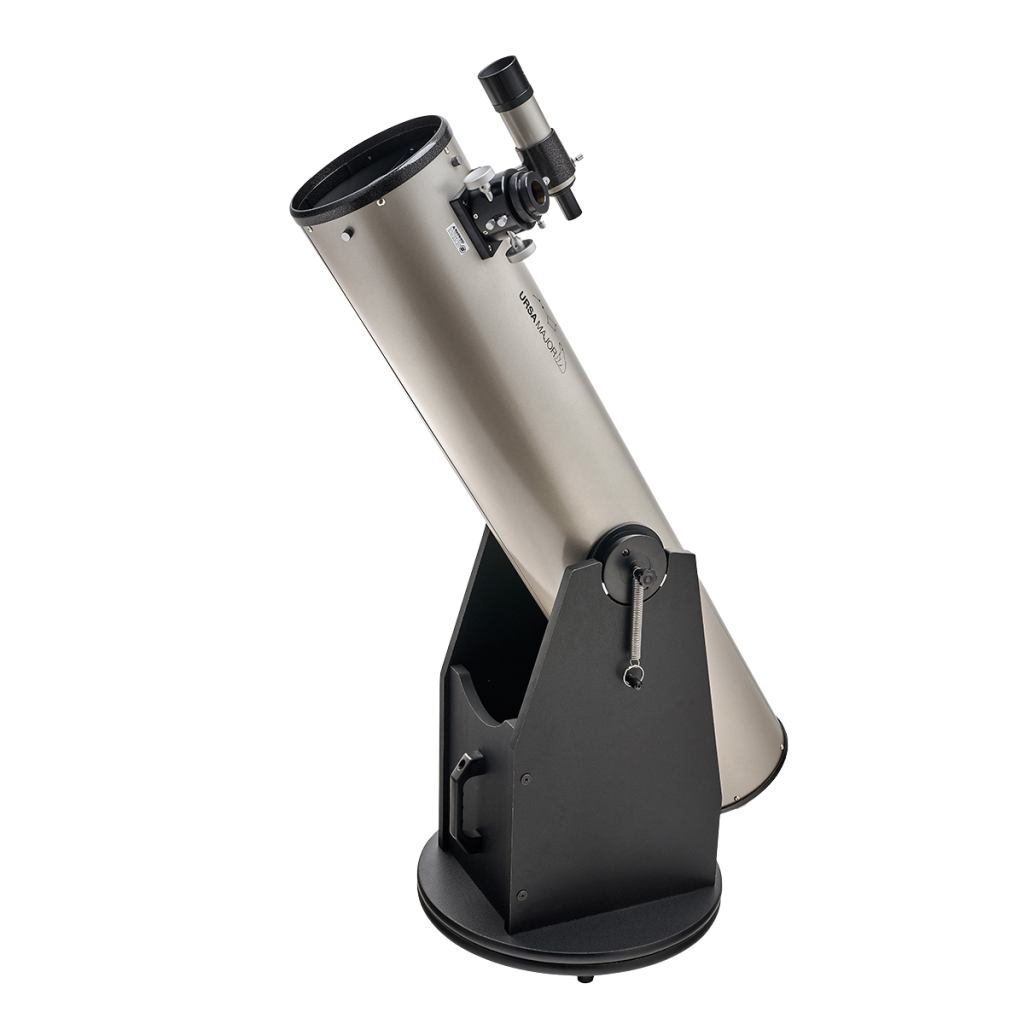
- Lots of aperture for the money
- Great optics
- Similar form factor and portability to a 6” Dobsonian
The Ursa Major 8″ Dobsonian is an affordable offering in the 8″ Dobsonian category, maintaining many of the core design elements found in the pricier 8″ models, whilst trimming down to the bare essentials. This Ursa Major 8″ Dobsonian delivers impressive performance for its price tag, thereby making it an attractive choice for those operating on a limited budget.
Sporting a tube roughly 1.2 metres in length, matched by a similarly broad base, this telescope is only slightly more cumbersome than a 6″ f/8 Dobsonian. However, this modest increase in bulk is compensated by a remarkable doubling of light-gathering capacity and a one-third increase in resolving power.
In addition, the Ursa Major 8″ Dobsonian is compatible with 2″ eyepieces, courtesy of its 2″ diameter single-speed Crayford focuser. A pair of 1.25” Plossl eyepieces and a 9×50 finderscope are also provided to get you started.
4. Best 8″ Dobsonian Telescope: StellaLyra 8” f/6
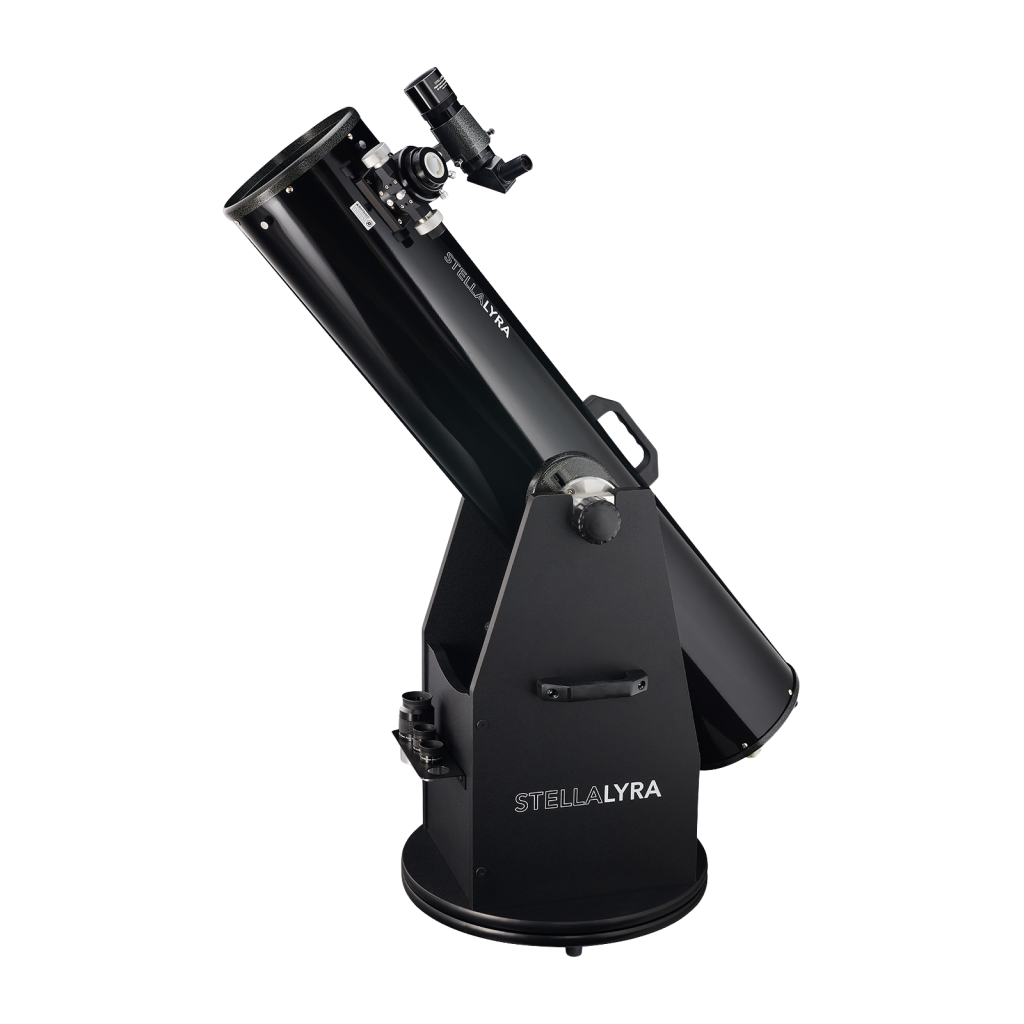
- Excellent combination of included accessories for a fairly low cost
- Sharp 8” optics
- Well-designed mount
My preferred choice for an 8” Dob is the StellaLyra 8″ f/6 Dobsonian due to its excellent performance, complete set of accessories provided straight from the package, and its amalgamation of features that one would usually expect to come with twice its price tag. No other telescope offers as much value for money as the StellaLyra 8″ f/6 does straight out of the box.
The StellaLyra 8″ f/6 mirrors the Ursa Major 8″, being an 8″ f/6 Dobsonian, but it comes with altitude bearings that can be adjusted in their positioning along the optical tube to achieve perfect balance. It boasts a sophisticated 2” dual-speed Crayford focuser. The 50mm finderscope it incorporates is a right-angle correct image model, although you might find it beneficial to supplement it with a Telrad. The StellaLyra 8″ f/6 offers adjustable bearing friction on both axes, and the altitude bearings can be slid along the tube to balance the telescope with accessories of varying weights.
The StellaLyra 8″ f/6 also includes a high-quality 30mm wide-angle 2” eyepiece for low power and a 9mm Plossl for high power, though you’ll certainly want something intermediate in focal length, as well as a shorter focal length, high-power eyepiece or two for a range of magnification and field of view options.
5. Best 8″ Computerized Dobsonian Telescope – Celestron StarSense Explorer 8”
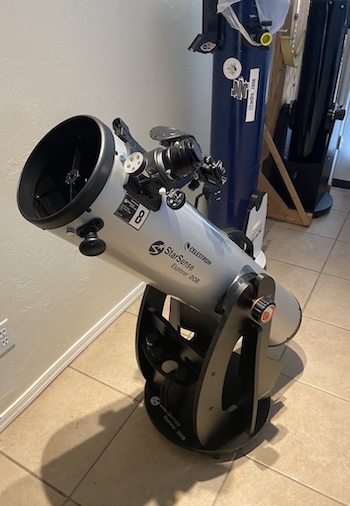
- StarSense Explorer technology assists in aiming
- Lightweight base makes for better portability
- Good performance
The StarSense Explorer 8” doesn’t come with a lot of features or accessories. We only get a single eyepiece, a red dot finder, and a single-speed focuser. However, the telescope uses Celestron’s StarSense Explorer technology to turn your smartphone into a precision-pointing device without the hassle of any additional electronics, batteries, or controllers.
The StarSense Explorer 8” also has a lightweight, optimised base with cutouts built-in along with numerous carrying handles, so it’s quite a bit more portable than the other 8” Dobsonians on our list. However, the price is a little high for what you get, and collimating the primary mirror in the field requires a screwdriver. If you’re okay with these compromises, however, the StarSense Explorer 8” Dobsonian makes for a great telescope.
6. Best 10″ Dobsonian Telescope – StellaLyra 10” f/5
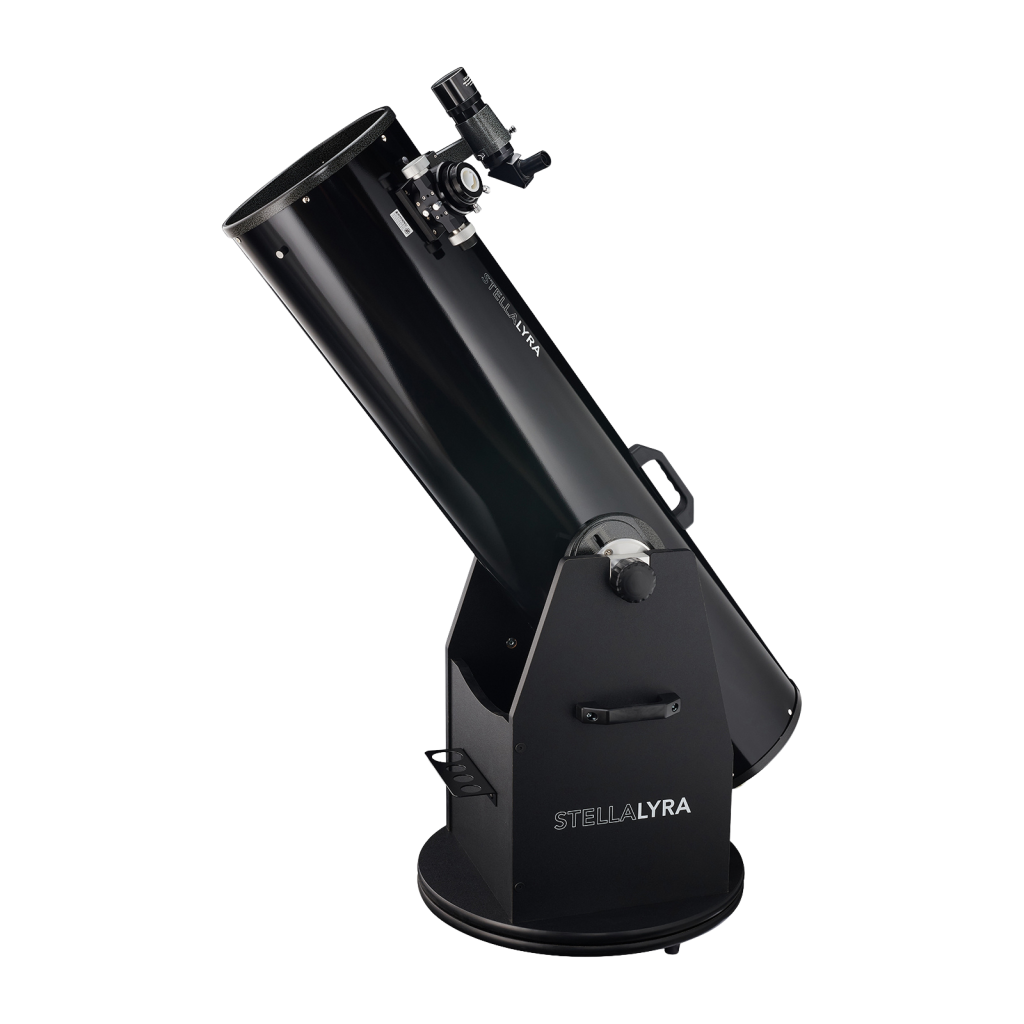
- Excellent combination of included accessories for a fairly low cost
- Sharp 10” optics for excellent lunar, planetary and deep-sky views
- About as portable as most 8” Dobs
The tube of this telescope is somewhat longer than that of a 6” or 8” Dobsonian, but not by a significant margin. However, the scope’s dimensions and weight render it a touch more unwieldy than its smaller counterparts.
The included 30mm eyepiece might display some off-axis coma and astigmatism in a fast scope like the StellaLyra 10″ f/5, but it delivers a considerably broader field of view than a 25mm Plossl, which is undeniably a massive advantage when locating and observing deep-sky objects.
With the StellaLyra 10″ f/5’s dual-speed Crayford focuser, high-power focusing becomes an absolute joy. The StellaLyra 10″ f/5’s cooling fan, while essentially a sophisticated computer fan attached to the rear end of the tube with a battery pack wired on, proves quite useful for a 25 cm scope.
Just like the StellaLyra 8″ f/6, the StellaLyra 10″ f/5 also includes a 9mm Plossl eyepiece, although the telescope is capable of handling significantly more magnification than the 133x it provides—a good 10″ scope can achieve up to 500x with proper collimation and calm skies, and the StellaLyra 10″ f/5’s dual-speed focuser makes focusing easier at these high magnifications.
7. Best 10″ Computerized Dobsonian Telescope – Celestron StarSense Explorer 10”
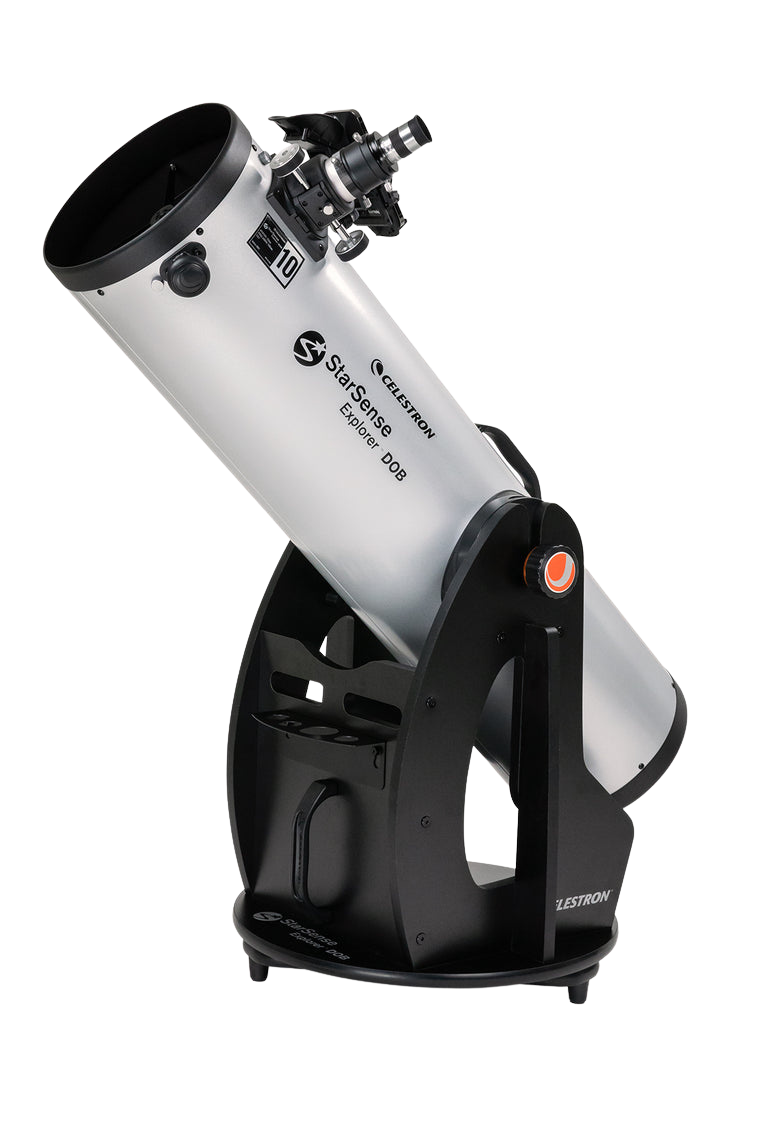
- StarSense Explorer technology assists in aiming
- Optimized, lightweight base makes for significantly better portability than competitors
- Great performance
As with the StarSense Explorer 8” Dobsonian, the StarSense Explorer 10” Dobsonian really doesn’t get you a lot of kit for the money; the main thing you’re paying for is the StarSense Explorer technology and lightened base design.
The StarSense Explorer 10” offers a lot of performance, as with any good 10” Dobsonian, and is significantly more portable than the 10” StellaLyra – however, it costs more than the StellaLyra 10” f/5 to begin with, and upgrading to have a similar set of accessories will put you into an even higher price range.
8. Best 12″ Dobsonian Telescope – StellaLyra 12” f/5
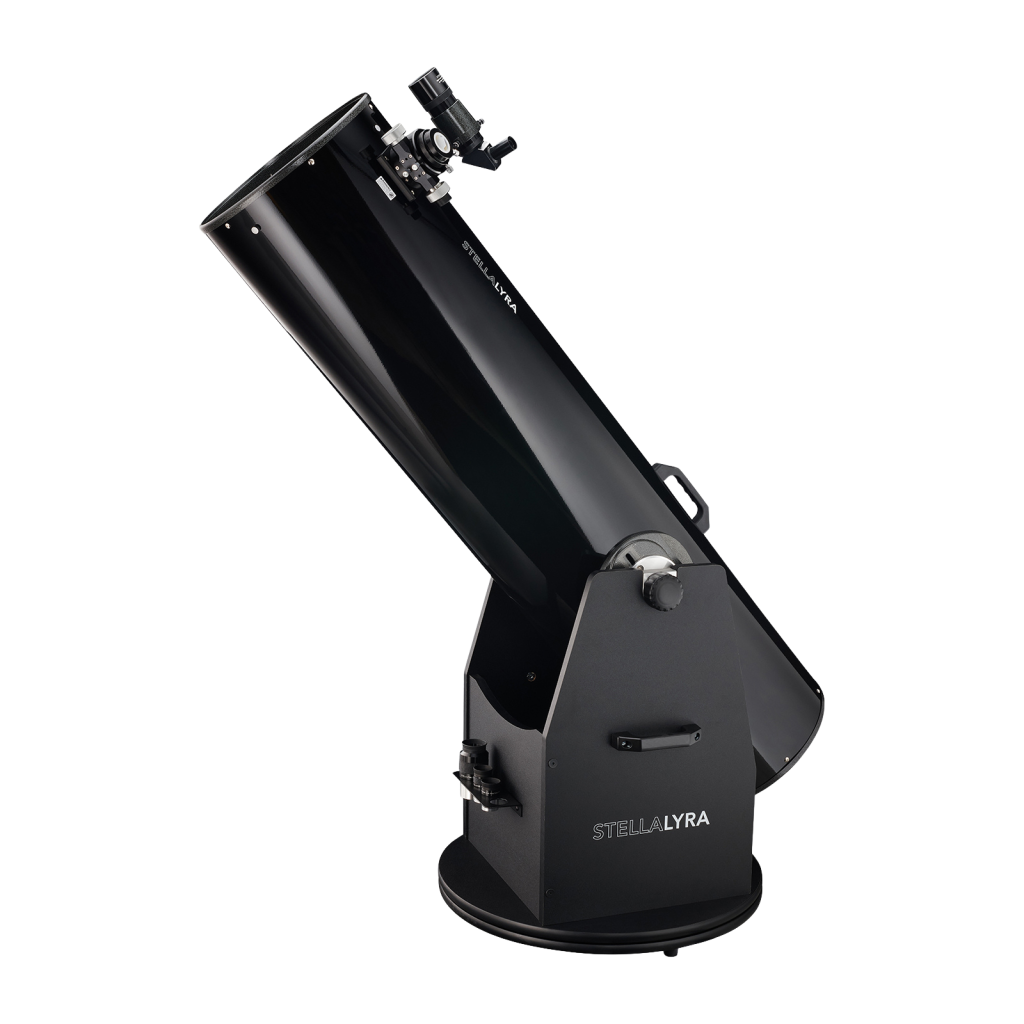
- Huge 12” aperture
- Lower price than collapsable/truss 12” telescopes
- Good set of provided features/accessories
The StellaLyra 12″ f/5 Dobsonian features the same sharp optics, 30 mm 2″ wide-angle eyepiece, cooling fan, dual-speed Crayford focuser, adjustable altitude bearings, 50 mm right-angle finderscope, and excellent optics that make the smaller StellaLyra scopes such a good value for the money. However, there are some practical considerations to bear in mind before purchasing this telescope.
Firstly: it’s heavy. 34 kilograms might not sound too excessive, particularly as it can be divided into two components. However, imagine having to load it into your vehicle to reach an observing site. Now envisage reloading that scope back into your vehicle, then unloading it.
The StellaLyra 12″ is also much larger physically than a 6″, 8″, or 10″ Dob. It’s a full foot longer, and the tube is 35 cm wide, with no good places to really grab it from. You’ll probably want straps or a helper to move the tube. Also, the length means it may not fit in smaller vehicles.
The StellaLyra 12″ is best if you have a smaller scope to complement it and/or a dolly and a garage so you can conveniently roll it out for observing. If you’re shopping for your first telescope, we would recommend getting something smaller and cheaper first before purchasing the StellaLyra 12″. But if you’re sure you’re hooked and can accommodate this massive instrument in your home and lifestyle, a 12″ Dobsonian like the StellaLyra 12″ can’t be beaten.
9. Best Portable 12″ Dobsonian Telescope – Skywatcher Skyliner 300P FlexTube Dobsonian

- Massive aperture but still fits in most vehicles
- Easy to set up and assemble
- Individual components not too heavy
The Sky-Watcher Flextube Dobsonians have some compromises in their design that make the 8” and 10” models rather unappealing, at least as a first choice. However, the Flextube 300P is a lot more portable than a solid-tubed 12” Dobsonian; its collapsable tube can fit across the back of a vehicle, whereas the long tube of a conventional 12” will need to have seats folded down – and plenty of available cargo space – to be transported.
The focuser on the Flextube 300P is only a single-speed, and it comes with a pair of rather basic 1.25” wide-angle eyepieces, but the scope features the same awe-inspiring views as any good 12” Dobsonian, and a right-angle 9×50 finder is included.
You’ll need to make or buy a fabric shroud to keep stray light out of this open-tubed instrument and probably find a way to roll the base around if you need to move it a significant distance, but the Flextube 300P is a great choice for those with smaller vehicles, families, and/or limited storage space options at home.
10. Best Computerized 12″ Dobsonian Telescope – Skywatcher Skyliner 300P FlexTube Dobsonian GoTo
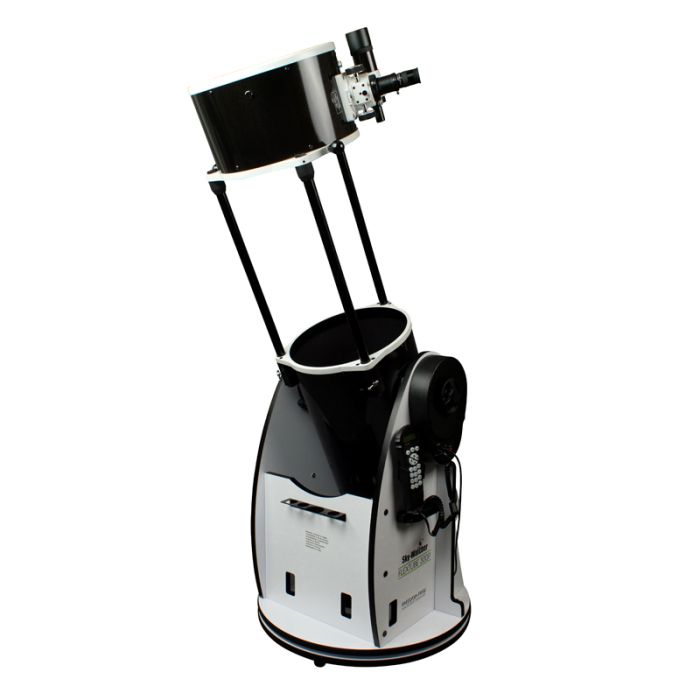
- Fully automatic motion and tracking
- Can still be used manually
- Great views, as with any 12”
The GoTo FlexTube 300P is largely the same as its manual counterpart but features full motorised pointing and tracking capability in all directions, controlled with the included handset; with an additional adapter you can run it with an app on your smart device. The FlexTube 300P GoTo can be used manually with the electronics powered off, or it can be pushed manually with the telescope fully activated and aligned without any impairment to its motorised pointing and tracking accuracy thanks to Sky-Watcher’s FreedomFind technology. This also allows you to push the scope partway to its targets if you are moving large distances around the sky to save power.
The motorised base of the FlexTube 300P GoTo is, however, quite heavy, and you might need help – or wheels – to move it around at all, as well as load it into a vehicle.
11. Best 14″ Dobsonian Telescope – SkyWatcher FlexTube 350P Dobsonian GoTo
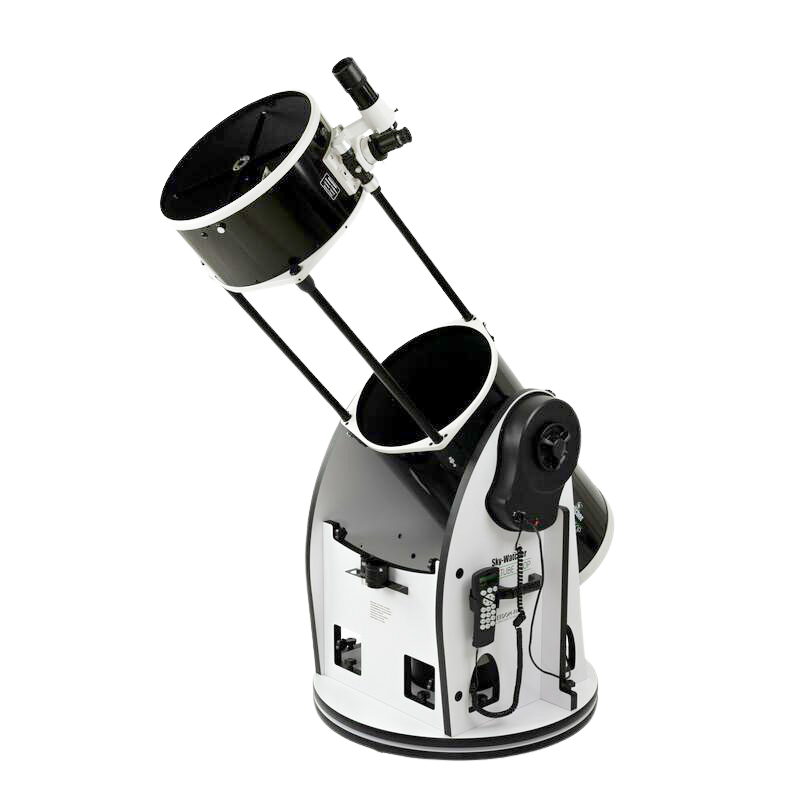
- 14” aperture for even brighter and bolder views, with motorised tracking and GoTo
- Base and tube both collapse for portability
- Dual-speed focuser
The FlexTube 350P Dobsonian is in some ways more portable than either the manual or GoTo FlexTube 300P variant. The reason? The whole base compacts flat with no tools and can be reassembled again in minutes. This allows you to save a lot of space when transporting the FlexTube 350P GoTo in a vehicle.
The FlexTube 350P GoTo also comes standard with a premium dual-speed Crayford focuser for ultra-fine adjustment when focusing at high magnifications. This scope is certainly not for the faint of heart and requires plenty of storage as well as a fairly large vehicle to transport it, but it will reward you with significantly brighter (by 36%) views than a 12” in a fairly portable and sturdy package.
The manual FlexTube 350P is also an excellent scope.
12. Best 16″ Dobsonian Telescope – StellaLyra 16″ f/4.5 Dobsonian
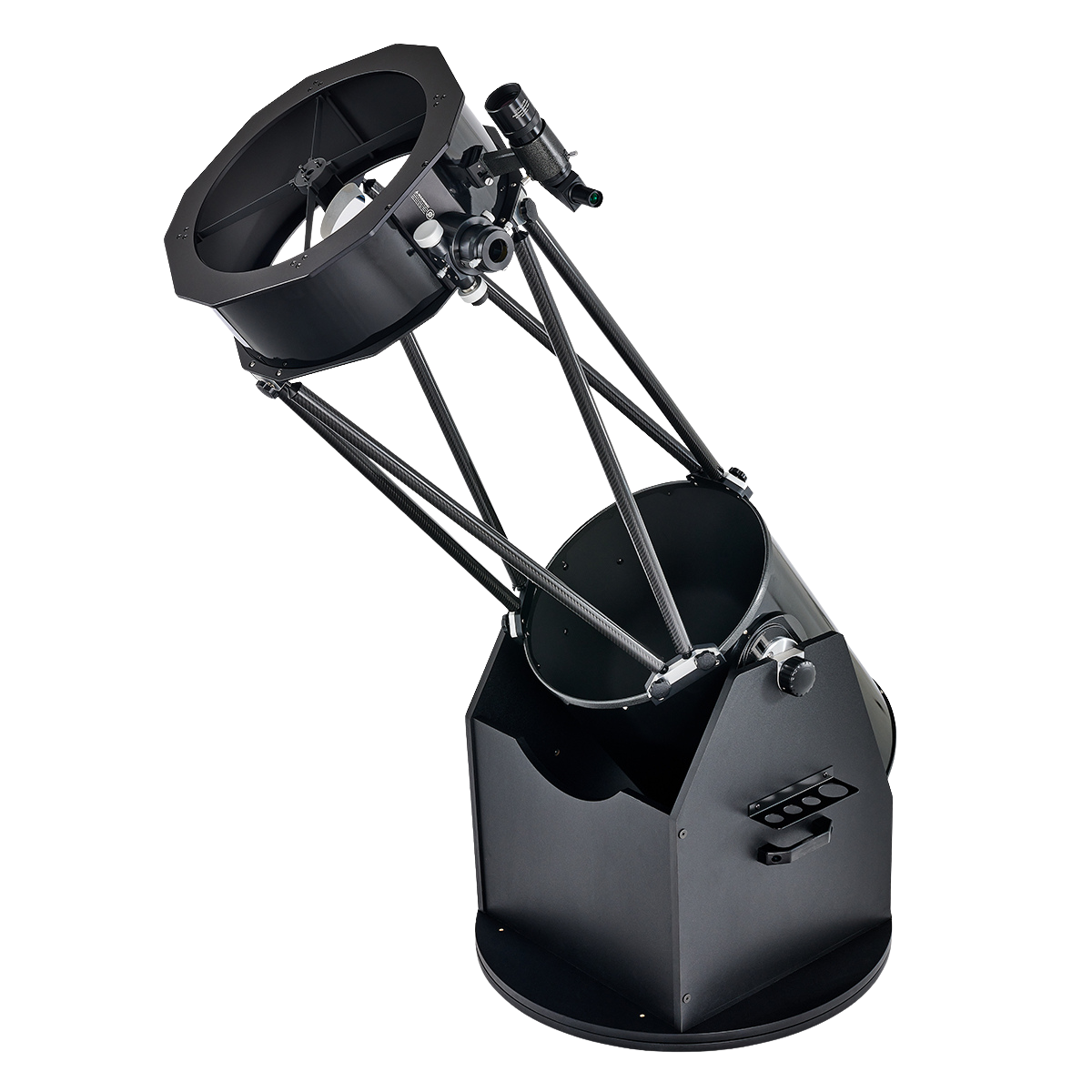
- Huge 16” aperture for the views of a lifetime
- Compact form factor when collapsed with no flimsy particle board or plastic parts
- Smooth mount movements & dual-speed focuser
The StellaLyra 16” f/4.5 Dobsonian is a monster telescope, but its carbon fibre poles easily break down in seconds, leaving you with the lower tube assembly, upper cage, poles, and a relatively beefy particle board base.
This scope has the same focuser, finder, and pair of provided eyepieces as the smaller StellaLyra Dobsonians, along with a built-in cooling fan.
The base of this scope is fairly heavy and needlessly wide thanks to its circular frame, but a DIY replacement is easy to construct out of 18 mm plywood.
You’ll need a shroud for the exposed truss tube as well, which can be handmade or purchased from a third party.
However, the huge mirror of this telescope will provide outstanding views of deep-sky objects if you can transport the telescope away from city lights.
Runners-Up
The Skyliner Classic Dobsonians from Sky-Watcher aren’t bad scopes, but the Dobsonians from Ursa Major, StellaLyra, and Bresser feature superior focusers as well as better-designed bearings. However, if our other recommendations aren’t available to you, we would definitely recommend going with one of the solid-tubed scopes from Sky-Watcher.
The Sky-Watcher FlexTube/collapsable design works really well with larger scopes, where it might make the difference between fitting in an automobile or not.
However, the 8” and 10” FlexTube models are not any lighter than their solid-tubed counterparts, and the space savings are really not much to brag about – and when you consider the need for a shroud, the nuisance of additional collimation (especially with the 8” model, which requires a screwdriver to adjust), and the price, there just isn’t much of a point.
GoTo versions of all of the FlexTube models are also available at a higher price but feature Sky-Watcher FreedomFind technology so you can still manually aim them.
- Explore Scientific 10”, 12” and 16” Ultra Light Dobsonians
While the Explore Scientific Ultra Light Dobsonians feature all-metal compact truss tubes and silky smooth bearing action, the high price and the additional spending required to get these scopes up and running make them less than appealing for a first-timer. However, if storage space is of huge importance and you have extra room in the budget, these are both good scopes.
The larger Bresser Messier Dobsonians feature wonderfully smooth bearings, fully adjustable and rotatable tube cradles, and well-designed focusers. However, the included accessories are useless, and the focusers are only single-speed; for the price, other options probably make more sense.
Tips On Choosing The Best Dobsonian
- Budget
If you’re on a tight budget, it’s probably best to get the largest scope for your pounds and worry about accessories later. However, don’t skimp to the point that you are unable to get everything you want out of your telescope.
- Try Before You Buy
If possible, I highly recommend borrowing a scope from a friend or at least examining it in person before purchasing it. Dobsonians are big, hefty instruments, and sales brochures are going to try to make them seem as small and portable as possible. Don’t buy something that looks small in pictures and then ends up being an unwieldy behemoth that you’ll never bother with – the best telescope is the one you’ll use.
- You Get What You Pay For
A cheap Dob nowadays probably won’t be compromised optically (thank goodness), but the accessories and things like the focuser will be cheapened. If you can afford them, the more expensive models for a given aperture are probably worth it.
- Who’s Using It?
If you’re using your Dob for outreach, you’ll want something portable but at the same time with as much aperture as possible – GoTo or digital setting circle assistance also helps, as you’ll save time locating targets. If you’re using it with your kids, portability may not be as much of a consideration, but the “wow” factor of the image, as well as your kids’ attention span, will dictate a lot of your choice of telescope.
If you’re buying a telescope for a child or teenager, I wouldn’t recommend going above 8 inches in aperture – collimation will be too difficult, and it’ll be too heavy for them to set up and use on their own.
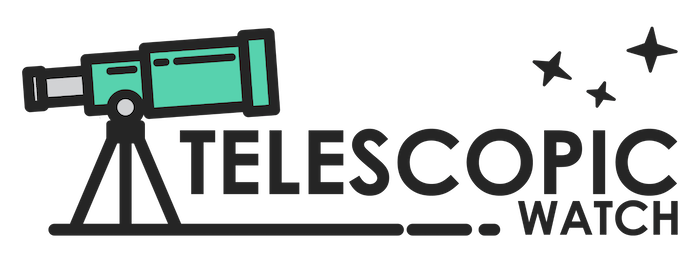
Hi Zane, thanks for the informative review of Dobs. New to stargazing, I am choosing between an Orion XT8i and XT10i. (BTW, based on your recommendations, I’ll supplement the scope with a Telrad, a set of four Goldline eyepieces and a copy of Turn Left at Orion.) I would like to get the larger aperture of the 10i but have a few questions:
1. I had not planned on purchasing a coma corrector. Am I better off sticking with the 8i over the 10i without a coma corrector?
2. Never having done collimation, is the collimation on the 10i much harder than on the 8i?
3. I plan to carry the scope up/downstairs. I’m comfortable lifting the 30 pound 10i tube but will it be too awkward to handle?
Any other considerations I’m not thinking of?
Thanks again.
The 10 is okay without a coma corrector, collimation isn’t much worse, but given that you’re dealing with stairs I’d get the 8
Hello, thanks for the information! Do you think an Orion Skyline 8″ is worth the higher cost vs the Orion Classic XT8? This would be my first more serious telescope.
And for each case, which additional accesories would you recommend? I live in Mexico and it is complicated to get astronomy equipment, so I will buy online from the US and I want to get most of the things I will need for the first two-three years of space watching.
Thanks!
I would get the Skyline (or the StellaLyra (in the case of UK) – whatever is cheapest).
Get good eyepieces in the 15mm and 6mm ranges, a 2″ UHC nebula filter, and a Telrad.
I am thinking seriously about a dobsonian telescope. I am an older adult, so I must do my homework, to insure I don’t make mission impossible for myself. I am thinking 12, 14 , or 16 inch telescope.
I like the idea of putting as much capital in on my first buy, so I won’t be unhappy with an inferior scope.
on the other hand I don’t want to put myself in the position of having to call a moving van to relocate my telescope.
so with only my computer and search engine to be my guide I am leaning towards a 14 inch dobsonian either a solid tube or flex tube scope! any advice on this issue. bill
Thank you,
First 100% understandable explanation of Dobs I have read.
Im looking into purchasing my first telescope.
Southwest Puerto Rico has beautiful night skies, still.
It will be a Dob.
Ricardo